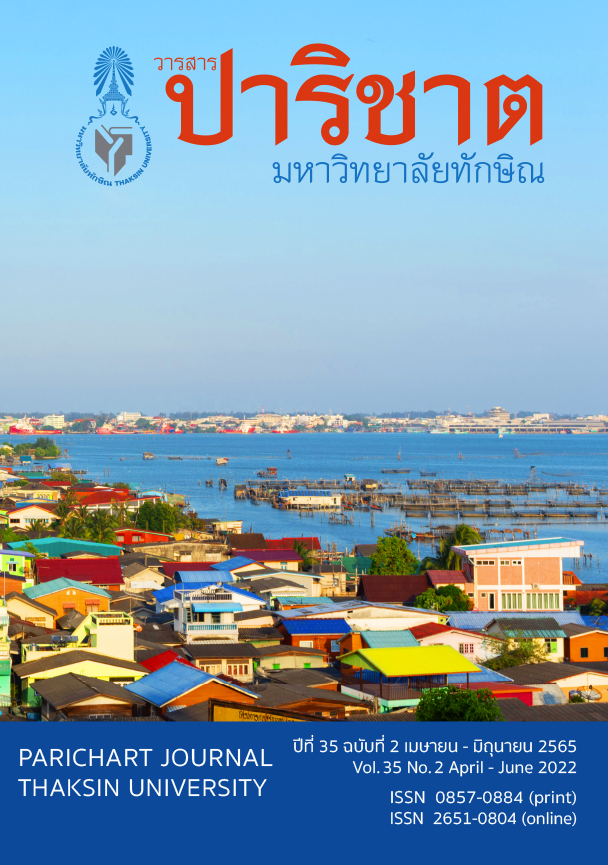The Formation of a Thai-Malaysian Contemporary Identity in Kedah State, Malaysia
Main Article Content
Abstract
This paper explores the construction of the Thai-Malaysian identity in the context of contemporary Malaysian society in Kedah state, Malaysia. The data are drawn from a combination of document research and a cultural anthropology study carried out in Kedah during 2018-2020. The findings reveal that these Thai-Malaysians speak Thai and practice Buddhism, they stand out in the Malay dominated Malaysian society. They want to be regarded as rightful Malaysian citizens with a distinctive cultural identity, and not foreign labour migrants from Thailand. The formation of the Thai-Malaysian identity in Malaysia is possible because of three factors. First, the Thai-Malaysian community has maintained cultural heritage such as Thai language and Buddhist belief. Second, the Malaysian state policies have opened up for other cultures that allow diversities to be part of the national culture. Third, Thai organizations have provided support for Thai cultural transmission among Thai-Malaysian youths in Malaysia. These three main factors contribute to the formation of a distinctive Thai-Malaysian identity within the framework of the Malaysian national identity.
Article Details

This work is licensed under a Creative Commons Attribution-NonCommercial-NoDerivatives 4.0 International License.
References
Omar, A. H. (2004). The encyclopedia of Malaysia : Languages and literature. Archipelago Press.
Phumplab, M., Meesanthan, C., & Kaprit, S. (2017). ASEAN societies. Ministry of Social Development and Human Security. (In Thai)
Pawakapan, N. (2015). Arguing the nation and ethnicity. Siam Paritut. (In Thai)
Soonthornpasuch, S. (2005). Ethnic relations. Muang Boran Press. (In Thai)
Barth, F. (1969). Ethnic groups and boundaries. Little Brown and Company Boston.
Sugunnasil, W. (2005). Globalization. National Research Council of Thailand. (In Thai)
Saiphan, P. (2014). Ethnicity: From liberalism to Neoliberalism. In Naruephon Duangwiset (Ed.). Ethnic and Neoliberalism. (pp.103-133). Bangkok: Princess Maha Chakri Sirindhorn Anthropology Centre. (In Thai)
Andaya, B.W., & Andaya L.Y. (2014). A history of Malaysia. The Foundation for the Promotion of Social Sciences and Humanities Texbooks Projects. (In Thai)
Turnbull, C. M. (1997). A history of Malaysia, Singapore and Brunei. Department of Curriculum and Instruction Development Ministry of Education. (In Thai)
Ayuwattana, T. (2004). Thais in Malaysia. Samnakphim Bannakij. (In Thai)
Kuroda, K. (2002). The Siamese in Kedah under nation-state making. Retrieved 5 July, 2020, from https://www.uni-muenster.de/Ethnologie/South_Thai/working_paper/Kuroda_Kedah.pdf.
Sathian, M.R., & Chesof, R. (2018). Siamese in Malaysia: Beyond sixty years of heritage. Social sciences and humanities textbooks foundation.
Rakvong, R. (2020). Thai language and culture in a contemporary context and the formation of a Thai-Malaysian Identity in Kedah, Malaysia. Master’s Thesis. Mahidol University. (In Thai)
Yunyasit, S. (2013). The Siamese of Malaysia: Linkage of Two Lands. In Suchada Thaweesit & Malee Sunpuwan & Sutthida Chuanwan (Ed.). Population and society in ASEAN: Challenges and opportunities. (pp. 83-100). Institute for Population and Social Research Mahidol University. (In Thai)
Nita J. (2020). Questions that i always get asked in Malaysia. Retrieved December 1, 2020, from https://www.facebook.com/kanita.trisya/videos/3699122993485418. (In Malay)
Johnson, I.C. (2005). Paradise at your doorstep: International border fluidity and cultural construction amongst Kelantan’s Thai community. In Wattana Sugunnnasil (Ed.). Dynamic Diversity in Southern Thailand. (pp.299-331). Silkworm Books.
Suanthitapanya, P. (1998). Malaysia: Unity and education. The Foundation for the Promotion of Social Sciences and Humanities Texbooks Projects. (In Thai)
Siripaisan, S., & Saksung, A. (2011) Bhumiputra: The history of the conflict and the development process of Malaysia. The Thailand Research Fund. (In Thai)
The Government of Malaysia’s Official Gateway.(2016). National Principles (Rukun Negara). Retrieved February 25, 2020, from https://www.malaysia.gov.my/portal/content/30110.
The National Department for Culture and Arts.(2020). National Culture Policy. Retrieved February 25, 2020, from http://www.jkkn.gov.my/en/national-culture-policy.
Klinsrisuk, P.(2016). Vision 2020. Retrieved June 15, 2019, from https://aseanpedia.wu.ac.th/site/readencyclopedia?id=195. (In Thai)
Razak, N. (2009). The 1Malaysia Concept Part 1. Retrieved June 15, 2019, from https://www.najibrazak.com/en/blog/the-1malaysia-concept-part-1.
Nualsanong, K. (2011). Thai language, religion and Thai culture learning in a temple of Siamese people in Malaysia. Department of Cultural Promotion, Ministry of culture. (In Thai)
Nualsanong, K. (2003). The social and cultural eevelopment of Tai peoples in the northern state of Malaysia. Department of Cultural Promotion, Ministry of culture. (In Thai)
Ismail, M.Y., & Suwannathat-pian K. (2006). Thai community. In H. Salleh (Ed.). The encyclopedia of Malaysia: People and traditions. 72- 73. National university of Malaysia.
Sriraksa, S. (2009). The culture of the Siamese in a northern Malaysian state: A case study of Klongmai village, Chitra, Kubang Pasu district, Kedah, Malaysia. Master’s Thesis. Mahidol University. (In Thai)
Tipsrinimit, N. (2012). The Malaysians of Thai descent the maintenance of cultural identity. Parichart Journal Thaksin University, 24(2), 167-194. (In Thai)[28] Nakseethong, P., & Puttichot, A. (2009). Thai people in Kedah: A study of Thai’s existence in Malaysia history (1785 - 2007). The Thailand Research Fund. (In Thai)
Kaeosanit, T. (2016). Dynamic construction of the Siamese-Malaysian’s ethnic identity, Malaysia. The Ph.D. thesis in Communication Arts and Innovation, The Graduate School of Communication Arts and Management Innovation, National Institute of Development Administration.
Tassanawongwara, C., & Hussin, H. (2019). Klong Yao and performance of minority identity in the Siamese community of Perlis, Malaysia. Malaysian Journal of Music, 8, 1-18.
Rizam, E. (2019). Tarian Siam ‘Klong Jhauu’ Sambut Peserta Konvoi. Retrieved August 31, 2019, from https://malaysiaaktif.my/62089. (In Malay)
Bunmak, S. (2011). The role of migrant networks among Malay-Thai workers in Tom Yam restaurants Malaysia. Humanities and Social Sciences, 37(1), 101-123. (In Thai)


